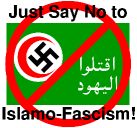U.S. UNIVERSITY TEXTBOOKS OMIT ISRAEL
How Do You Say 'Israel' in Arabic? You're not going to find the answer in your text book. by David Adesnik (Weekly Standard)
Well, how do you say 'Israel' in Arabic? The wrong way to answer that question is by consulting a textbook for first-year students of Arabic. Those textbooks will instruct you almost immediately how to say 'Palestine' or even 'Mauritania.' One of them even includes a handsome drawing of the young Yasser Arafat, with his full black beard. But when it comes to Israel, these textbooks remain silent.
Two textbooks for introductory Arabic predominate on American campuses. They are Al Kitaab fii Ta`alum al-`Arabiyya: A Textbook for Beginning Arabic, published in 1995 by Georgetown University Press and Ahlan wa Sahlan: Functional Modern Standard Arabic for Beginners, published in 2000 by Yale. The production of the former, known to students simply as Al-Kitaab (literally, "the book"), was supported by a grant from the National Endowment for the Humanities.
Teaching geography is a major concern of both textbooks. Page six of Al-Kitaab includes a map of the Arab world and a list of the nineteen countries it comprises. Ahlan wa Sahlan provides one map of the Arab world in its introduction, followed by another on page fifty-one and a list of all the Arab capitals on page 52. Although I thought I was pretty good at world capitals, I was surprised to learn that the capital of Mauritania is Nouakchott. I was even more surprised to learn that the capital of Palestine is Jerusalem. Not East Jerusalem. Just Jerusalem.
Maps present quite a challenge for a book determined to avoid using the word 'Israel,' either in English or Arabic. Maps tend to have fairly specific labels, which raises the question of what name to give the tract of land that separates the River Jordan from the Mediterranean Sea. The most common answer for both textbooks is no name at all. In Ahlan wa Sahlan, there are no fewer than twelve maps that include the Holy Land. Ten of them refuse to attribute to that land any name at all. Two of them use the word 'Palestine,' although in a way that makes it impossible to tell how much of the Holy Land Palestine covers. ....
Although it may be impossible to discern the motivations of the authors, one should compare their silence with the more direct approach taken by Arab media. On the Al Jazeera homepage, you can find the word 'Israel' in both English and Arabic. The same is true of the homepage for Asharq Al-Awsat, the internationally-read Arabic newspaper headquartered in London. If Al Jazeera and Asharq Al-Awsat can suggest to their massive audiences that Israel does exist (regardless of whether it should), then perhaps introductory-level textbooks written by professors at American universities can do the same. When the next editions of Al-Kitaab and Ahlan wa Sahlan are published, perhaps their authors will make their peace with geographic reality.



























No comments:
Post a Comment